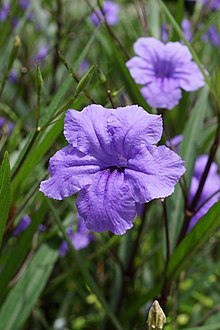Ruellia simplex
| Ruellia simplex | |
|---|---|

| |
| Scientific classification | |
| Kingdom: | Plantae |
| Clade: | Tracheophytes |
| Clade: | Angiosperms |
| Clade: | Eudicots |
| Clade: | Asterids |
| Order: | Lamiales |
| Family: | Acanthaceae |
| Genus: | Ruellia |
| Species: | R. simplex
|
| Binomial name | |
| Ruellia simplex | |
| Synonyms | |
|
See text | |
Ruellia simplex, the Mexican petunia, Mexican bluebell or Britton's wild petunia, is a species of flowering plant in the family Acanthaceae that is native to Mexico, the Caribbean, and South America. It has become a widespread invasive plant in Florida, where it was likely introduced as an ornamental before 1933,[1][2] as well as in the eastern Mediterranean, South Asia and other parts of the eastern hemisphere.
Taxonomy and synonyms
[edit]Ruellia simplex C.Wright is the oldest and accepted name for this species, which has been variously called Ruellia angustifolia (Nees) Lindau, Ruellia brittoniana Leonard, and Cryphiacanthus angustifolius Nees, among several synonyms.[3] The genus is named after French botanist Jean Ruel, while the specific name refers to the simple, not compound leaves.[4]
Description
[edit]Ruellia simplex is an evergreen perennial growing 3 ft (0.91 m) tall, forming colonies of stalks with lance-shaped leaves that are 6 to 12 in (15 to 30 cm) long and .5 to .75 in (1.3 to 1.9 cm) wide.
The flowers are metallic blue to purple, trumpet-shaped with an about 2 in (5.1 cm)-wide, five-lobed corolla. There is a dwarf variety that is only 1 ft (0.30 m) tall.[1]
Distribution
[edit]Ruellia simplex is native to Mexico, the West Indies, western Bolivia, southwestern Brazil, Paraguay, Uruguay, and northeastern Argentina. It has been widely used as an ornamental plant and has escaped from cultivation in the United States, Australia and parts of Asia, as well as several Pacific Islands. It is one of the most common landscape plants in Dubai, due to its drought-tolerance.[5]
It has become invasive in some of these areas, forming dense, single-species stands of vegetation which threaten native plants. It is mainly a plant of wet places such as ditches, pond verges, lakesides and marshes, but can survive in drier conditions.[6]
Control
[edit]The University of Florida's Institute of Food and Agricultural Sciences is trying to reduce the number of home gardeners who plant R. simplex by recommending alternatives, especially Silphium asteriscus, Sisyrinchium angustifolium, Stachytarpheta jamaicensis, Stokesia laevis, but also including some R. simplex cultivars that are sterile.[7]
-
Dwarf Mexican Petunia or Katie Pink or Katie Ruellia -- Ruellia simplex
-
Wild Petunia—Ruellia Simplex
-
Ruellia simplex, pink
-
Ruellia simplex, white
-
Trumpet shaped flowers
-
Leaves and stem
-
Blooms often fall within hours.
References
[edit]- ^ a b "Ruellia simplex". FLIP (Florida Invasive Plants). University of South Florida. Retrieved 5 September 2012.
- ^ "Ruellia simplex". Germplasm Resources Information Network. Agricultural Research Service, United States Department of Agriculture. Retrieved 14 January 2018.
- ^ "Ruellia simplex C.Wright". The Kew Plant List. Retrieved 5 September 2012.
- ^ "Ruellia simplex". Landscape Plants for South Florida. Palm Beach State College. Retrieved 5 September 2012.
- ^ "Top 20 Most Common Flower Plants in Dubai". Picture This. Retrieved 21 March 2024.
- ^ "Ruellia simplex (Mexican petunia)". Invasive Species Compendium. CABI. Retrieved 8 August 2020.
- ^ "ENH1207/EP468: Alternatives to Invasive Plants Commonly Found in Central Florida Landscapes". Electronic Data Information Source (EDIS). Institute of Food and Agricultural Sciences (IFAS), UF. 2018-08-29. Retrieved 2021-10-06.
External links
[edit]- Ruellia simplex in Florida. Atlas of Florida Vascular Plants.
- IPNI Listing







